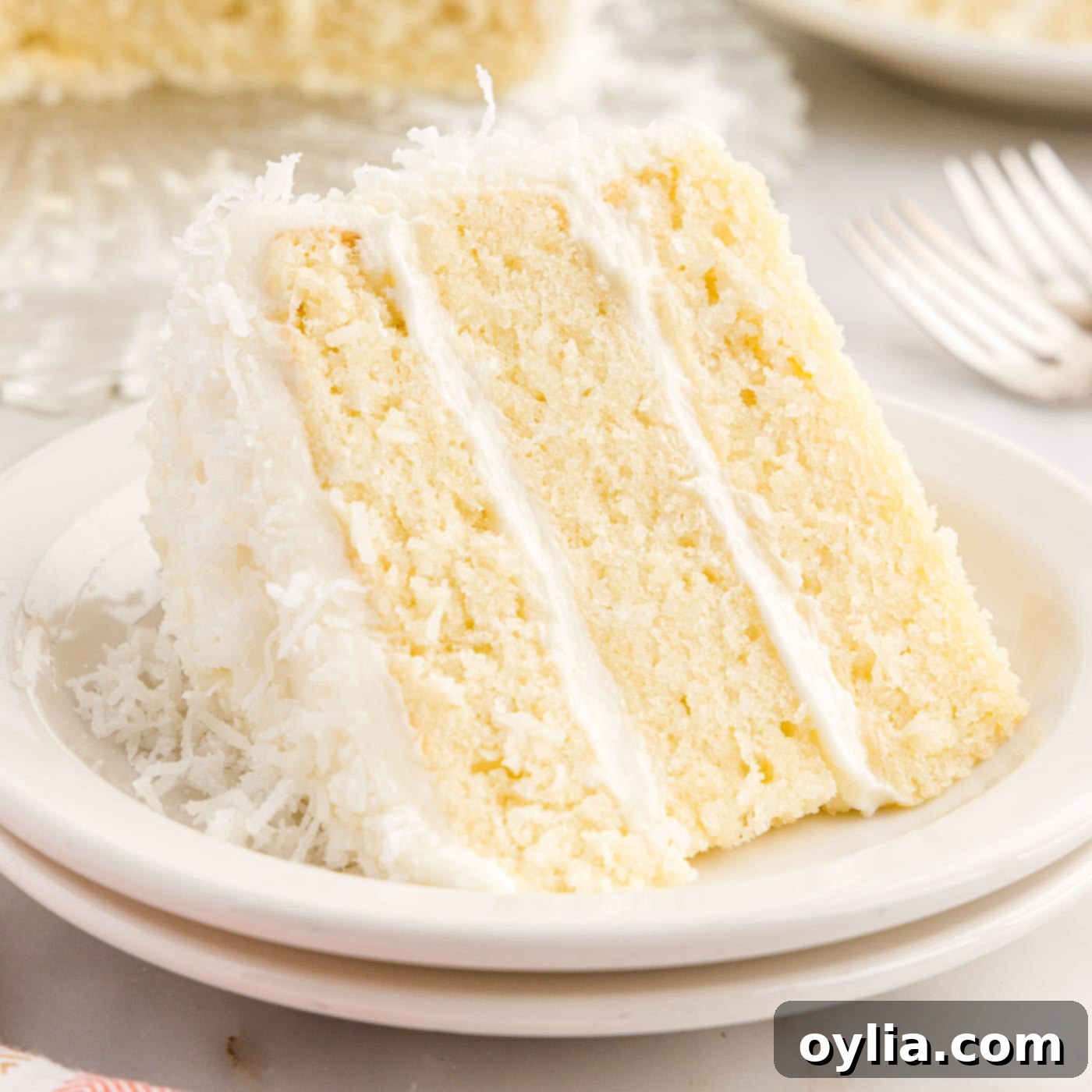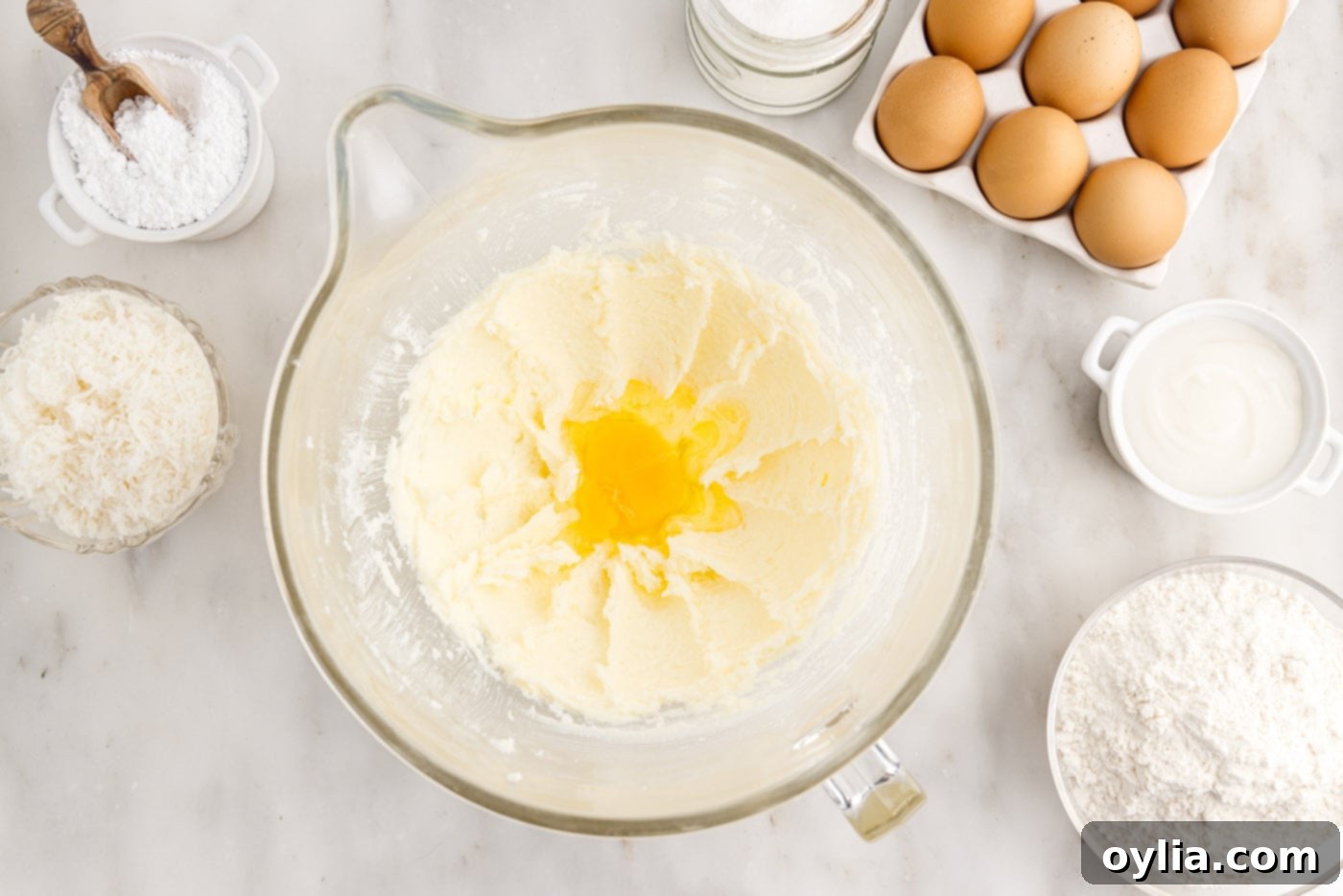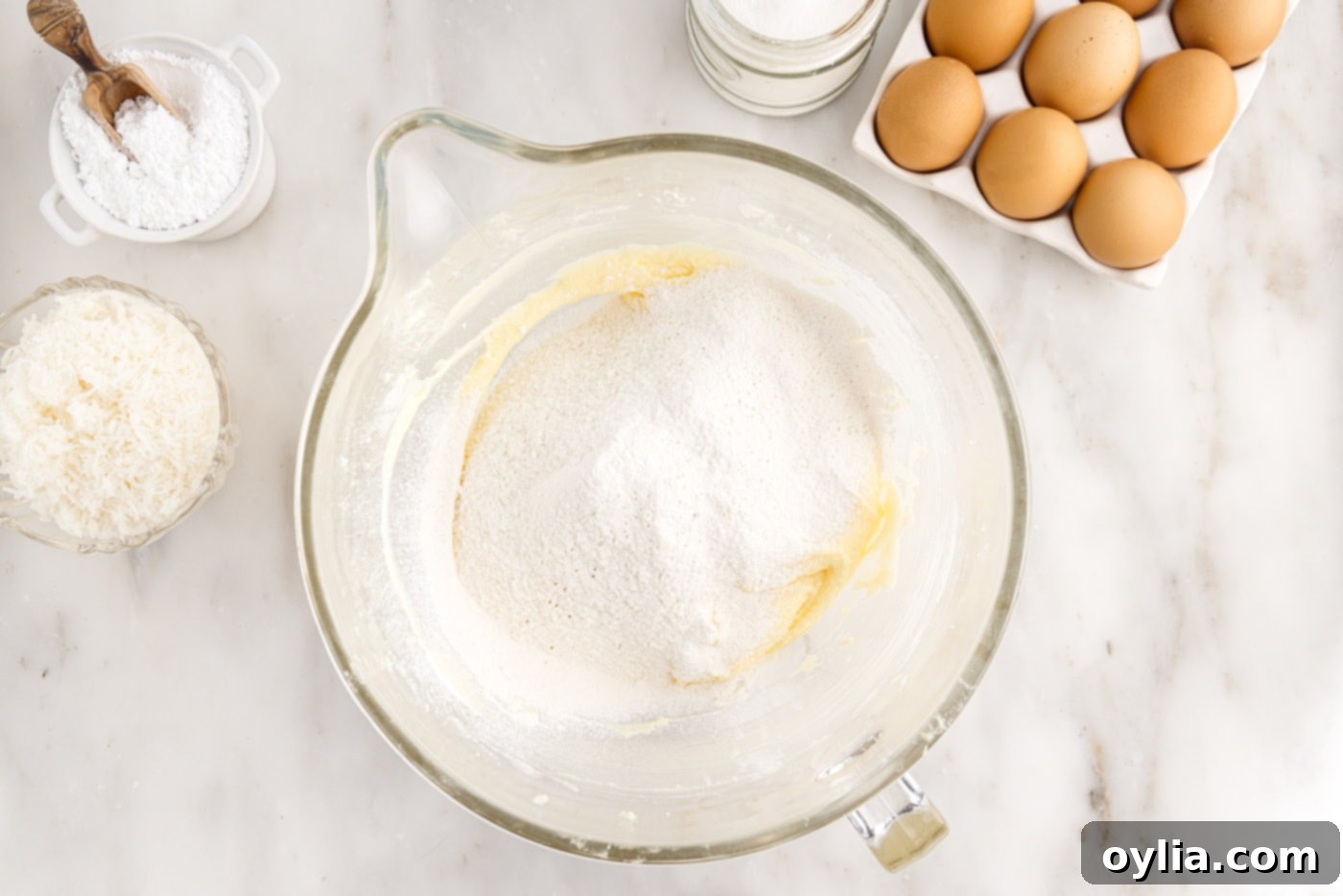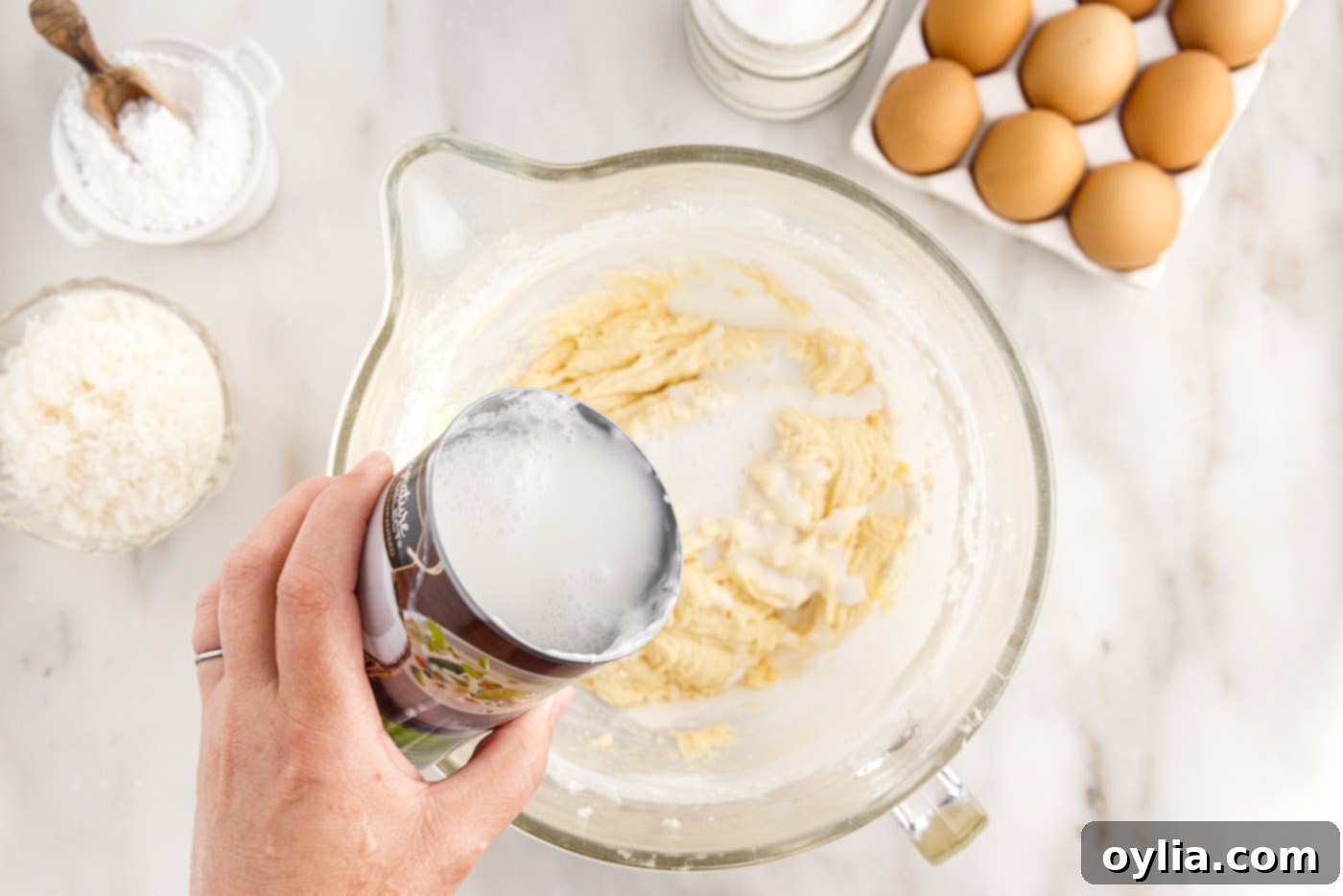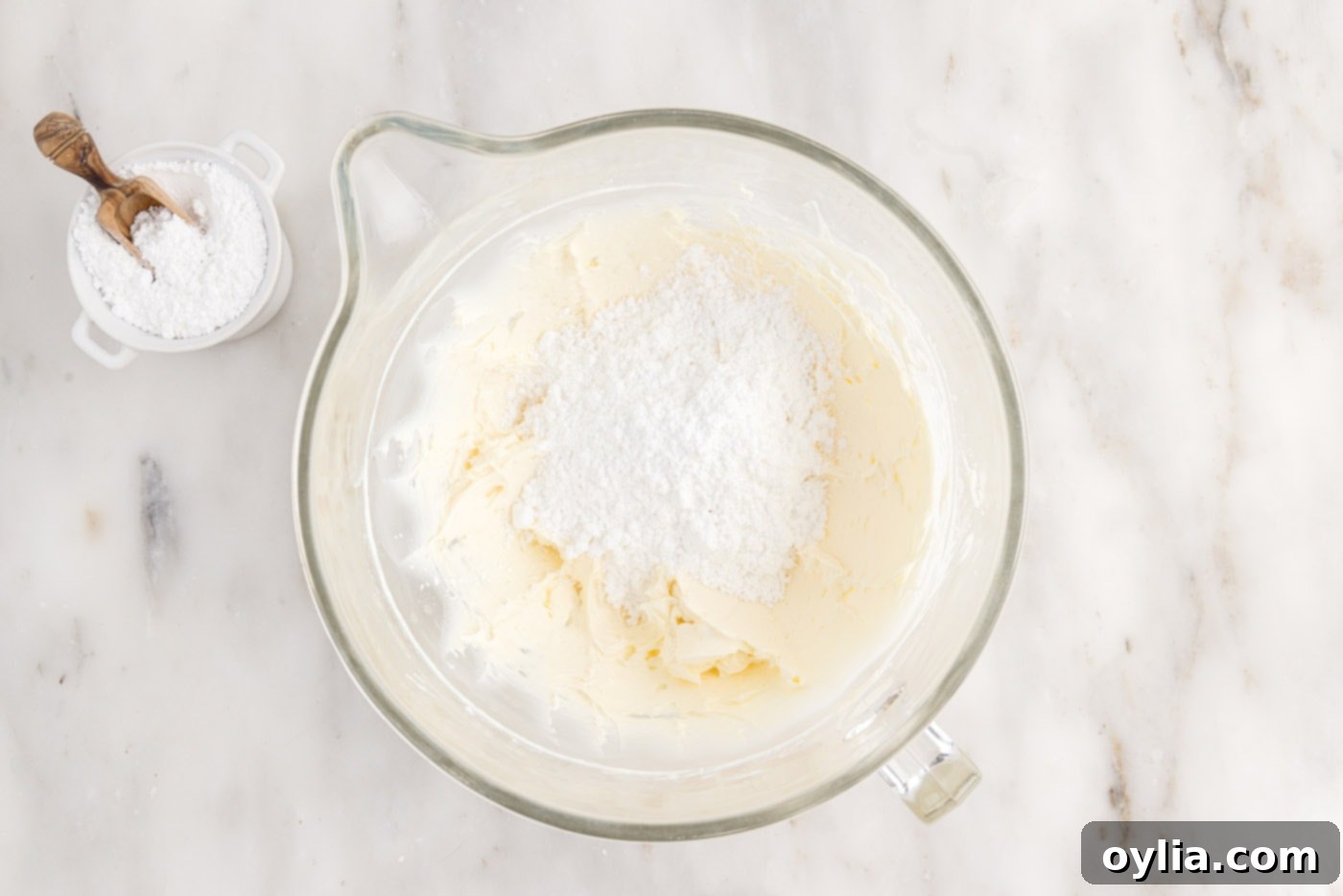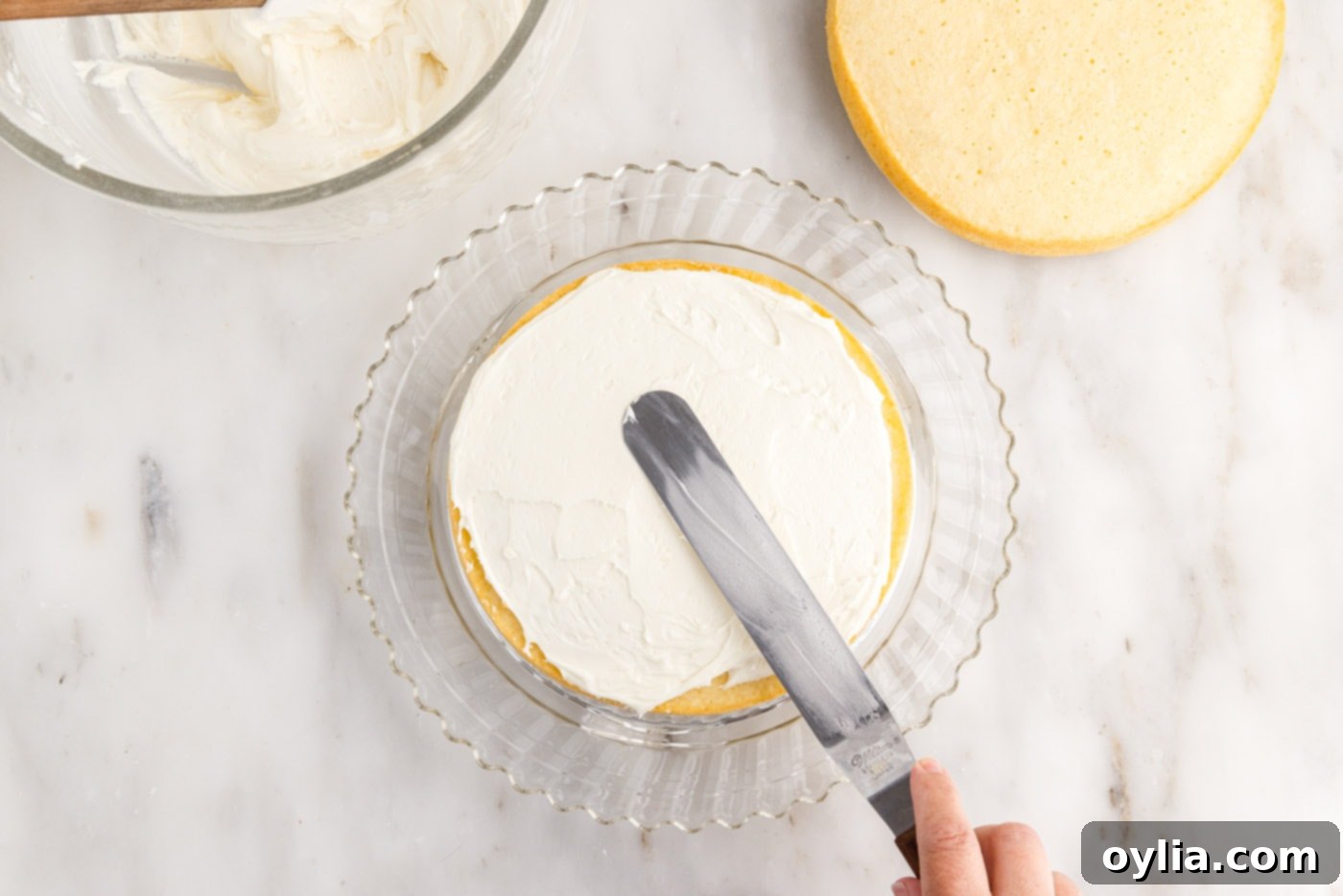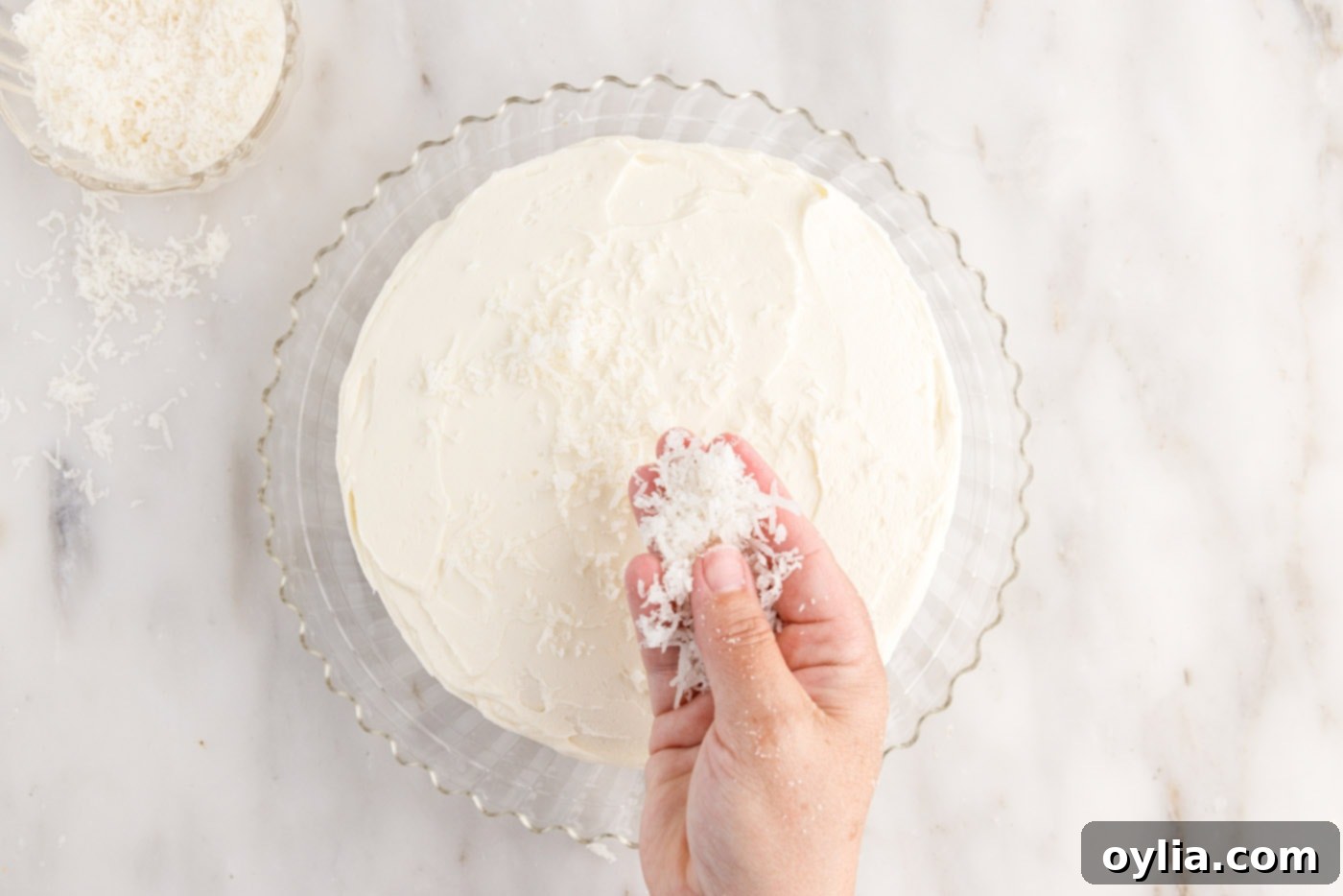The Ultimate Moist Coconut Cake with Fluffy Cream Cheese Frosting
Prepare to be enchanted by this truly exquisite homemade coconut cake. Each slice reveals layers of incredibly soft, rich, and tender cake, brimming with a delightful sweet coconut flavor that transports your taste buds to a tropical paradise. Crowned with a luscious, fluffy cream cheese frosting and generously adorned with shredded coconut, every single bite is a symphony of textures and tastes. This isn’t just any coconut cake; it’s a celebration in itself, promising perfection for every occasion.
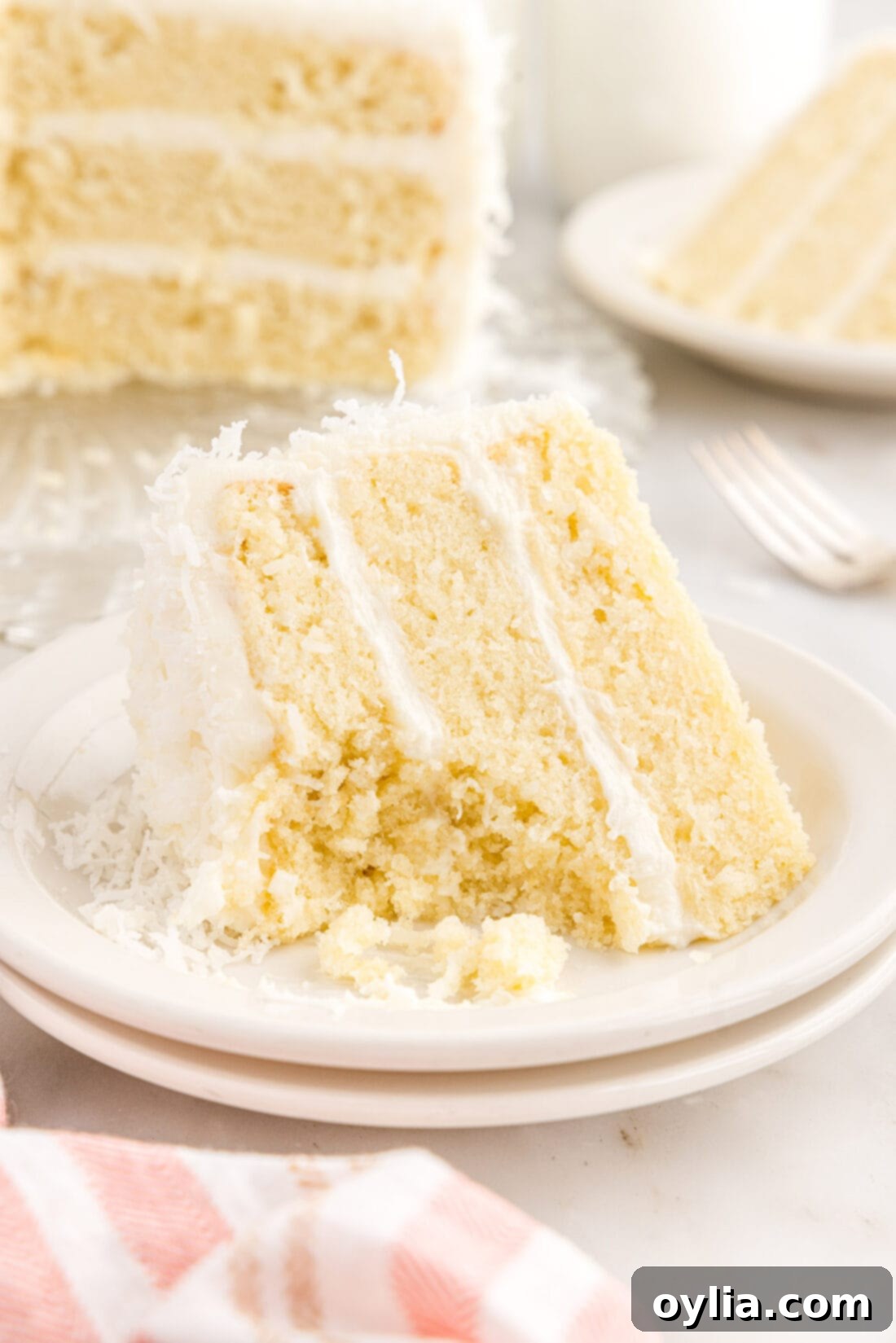
Why This Is Your New Go-To Coconut Cake Recipe
This tiered coconut cake recipe isn’t just good; it’s exceptionally good, and here’s why it stands out. We take coconut flavor seriously, layering it throughout the cake itself. The secret lies in a harmonious blend of coconut extract for intense aroma, rich cream of coconut for deep sweetness and moisture, and delicate coconut milk to keep the crumb tender. This triple-coconut approach ensures that every forkful delivers an undeniable tropical punch, preventing any blandness often found in lesser recipes.
The cake layers themselves are a masterpiece of texture: incredibly soft, supremely moist, and delicately tender, boasting a slight chewy crumb that keeps you coming back for more. This perfect consistency is a testament to the careful balance of ingredients and precise baking instructions.
But what truly elevates this dessert is the accompaniment of our signature cream cheese frosting. Its tangy richness cuts through the sweetness of the cake beautifully, creating a delightful contrast that enhances the overall flavor profile. Each thick layer of frosting binds the cake tiers, providing a luscious creamy mouthfeel. Finally, the generous coating of shredded coconut not only adds fantastic texture and an extra burst of coconut flavor but also creates a stunning, snow-white presentation that’s as beautiful to behold as it is delicious to eat. This cake isn’t merely a dessert; it’s an experience, guaranteed to impress and satisfy.
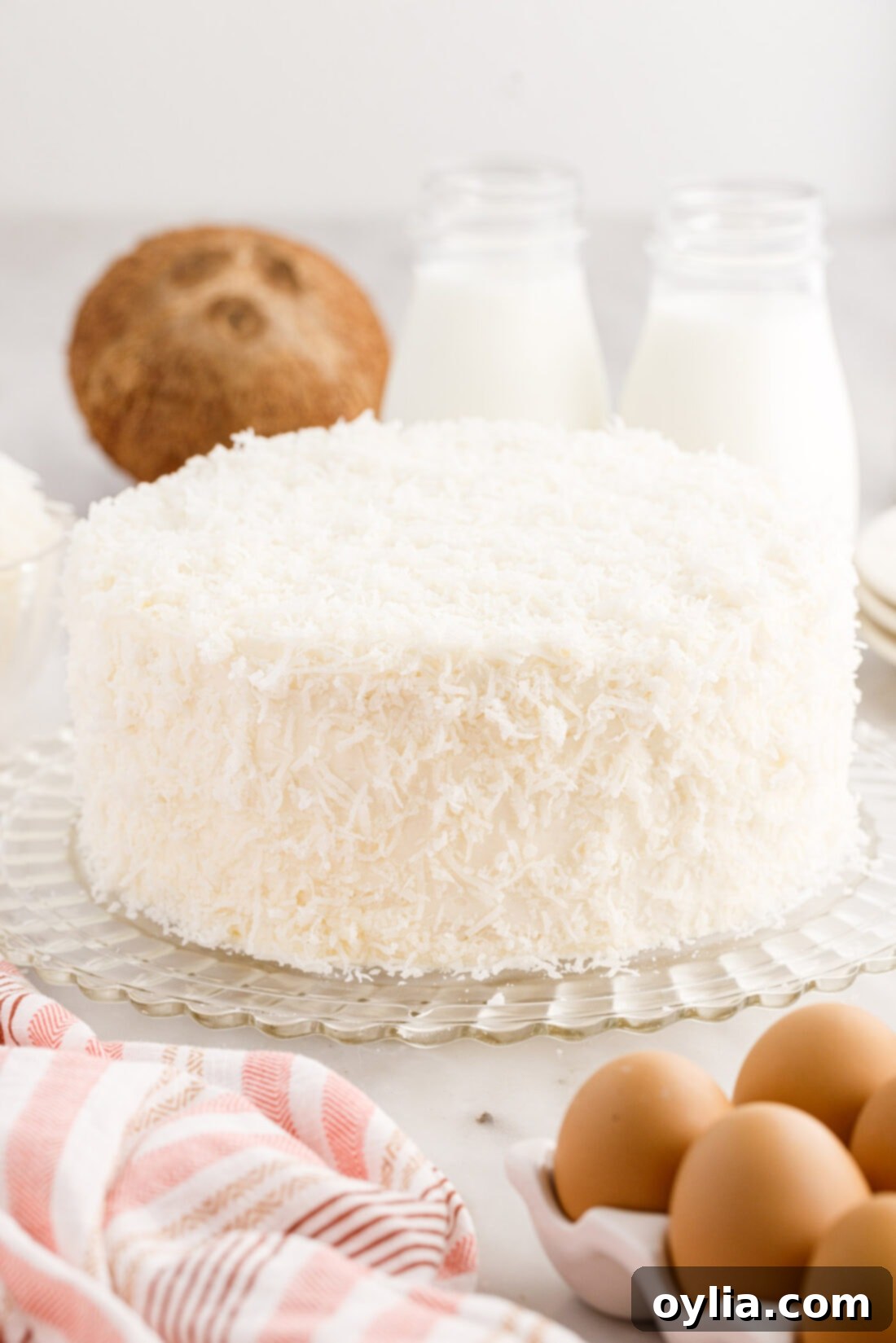
Essential Ingredients for Your Perfect Coconut Cake
To embark on your journey to baking this spectacular homemade coconut cake, you’ll need a selection of fresh, high-quality ingredients. We’ve carefully chosen each component to maximize flavor and achieve that desirable moist, tender crumb. You’ll find all precise measurements, a complete list of ingredients, and detailed instructions in the printable recipe card located conveniently at the end of this post. For best results, ensure your refrigerated ingredients like butter, eggs, and cream cheese are brought to room temperature before you begin.
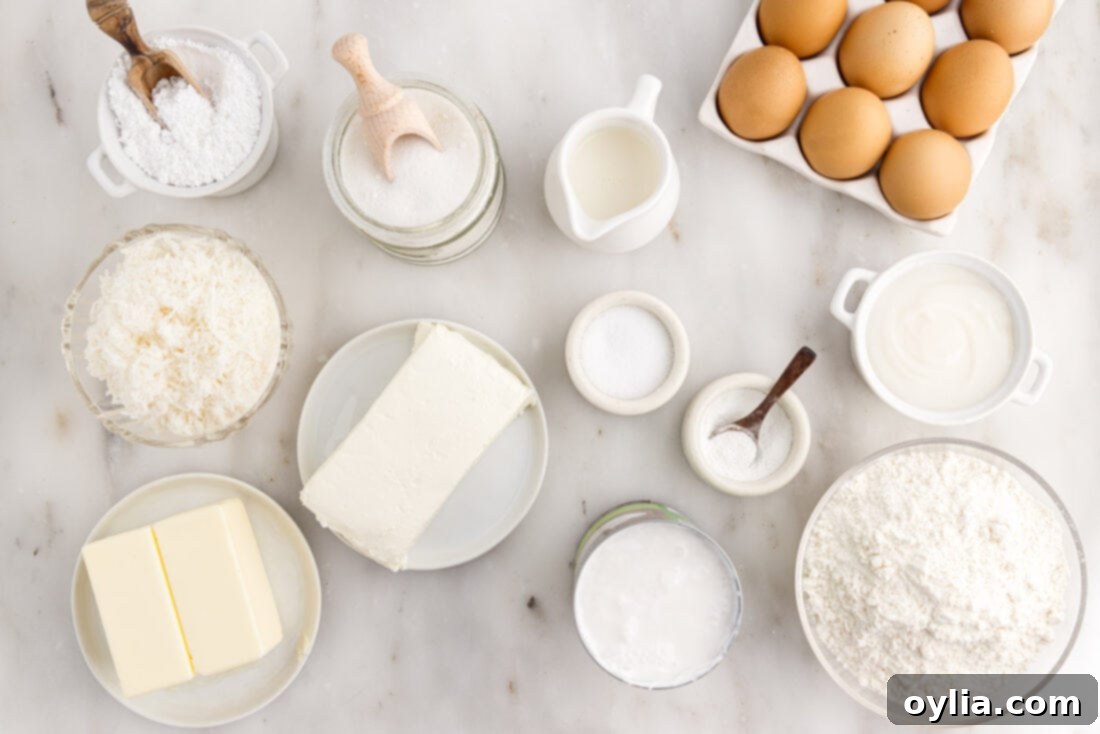
Ingredient Spotlight & Expert Substitution Tips
Understanding each ingredient’s role and having smart substitution options can make your baking experience even more enjoyable and adaptable.
- CAKE Base: While unsweetened coconut milk is key for our layered coconut flavor, you can absolutely substitute it with whole milk or 2% milk if preferred or if coconut milk isn’t available. Don’t worry about losing that signature tropical taste; the powerful combination of coconut extract and rich cream of coconut ensures the coconut essence shines through brilliantly, even with dairy milk. Using room temperature milk is crucial for a smooth batter that emulsifies properly.
- COCONUT for Texture and Garnish: The recipe calls for shredded coconut, and you have options! Sweetened shredded coconut will add a touch more sweetness and chewiness, while unsweetened will let the pure coconut flavor come through more. For an enhanced flavor and visual appeal, consider using toasted coconut both on top of and within the cake layers. To toast, simply spread your desired amount of shredded or flaked coconut in a single layer on a baking sheet. Bake in a 350°F (175°C) oven for a short 3-5 minutes, keeping a close eye on it, until it turns a beautiful golden brown. Immediately remove it from the hot baking sheet to prevent further cooking. Flaked coconut (larger shreds) or finely shredded coconut will work equally well, depending on your preferred texture.
- FROSTING Foundation: Our beloved cream cheese frosting provides a delightful tangy counterpoint to the sweet cake. However, if you’re looking for an alternative or a different flavor profile, a simple vanilla buttercream is a fantastic choice. The key to perfect cream cheese frosting is using softened, full-fat cream cheese and unsalted butter. Ensure both are at true room temperature for a smooth, lump-free, and perfectly fluffy frosting.
- Butter & Sugar: For the cake, use unsalted butter at room temperature. This allows it to cream properly with the sugar, incorporating air for a lighter cake structure. Granulated sugar not only sweetens but also aids in moisture retention.
- Eggs: Large eggs at room temperature are essential for emulsification, binding the ingredients, adding richness, and providing some leavening. Add them one at a time, beating well after each, to ensure a smooth batter.
- Flour, Baking Powder, Salt: All-purpose flour provides the cake’s structure. Baking powder is our leavening agent, giving the cake its rise and airy texture. Salt balances the sweetness and enhances all the other flavors. Proper measurement (spoon and level) is key for flour.
- Cream of Coconut: This is a thick, sweetened coconut product, often found near cocktail mixers or in the international foods aisle. It’s different from coconut milk and is crucial for the rich, moist texture and intense coconut flavor.
Step-by-Step Guide: Crafting Your Perfect Coconut Cake
These step-by-step photos and detailed instructions are here to help you visualize how to make this delightful recipe. For the complete, printable version of this recipe, including all precise measurements and instructions, simply Jump to Recipe at the bottom of this page.
- Begin by preheating your oven to 350°F (175°C). Prepare three 8-inch round cake pans by spraying them generously with non-stick baking spray. For easy release and to prevent sticking, line the bottoms of each pan with a circle of parchment paper. This step is crucial for beautifully intact layers.
- In a large mixing bowl, using a hand mixer or stand mixer, beat the softened butter and granulated sugar together until the mixture is light, fluffy, and creamy. This creaming process incorporates air, essential for a tender cake. Then, add the eggs one at a time, beating well after each addition to fully incorporate them and create a smooth emulsion.


- Next, introduce the vanilla extract, coconut extract, and cream of coconut to the wet ingredients. Beat thoroughly until all these delightful flavors are well combined and the mixture is smooth.

- In a separate, medium-sized bowl, whisk together the dry ingredients: all-purpose flour, baking powder, and salt. Ensuring these are well combined prevents pockets of leavening agents in your cake.
- Now, it’s time to combine the wet and dry mixtures. Alternate between adding the coconut milk and the flour mixture to the cake batter. Start and end with the flour mixture, and mix only until the ingredients are just combined. Overmixing at this stage can lead to a tough cake, so be gentle.


- Gently fold 1 cup of shredded coconut into the completed batter. Use a spatula for this step to maintain the airy texture you’ve built.


- Evenly divide the luscious batter among your three prepared cake pans. For perfectly level layers, use a kitchen scale to ensure each pan receives the same amount of batter.
- Bake for approximately 20 minutes. The cake is done when a toothpick inserted into the center of a cake layer comes out with just a few moist crumbs attached, but no wet batter. Be careful not to overbake, as this can lead to a dry cake.
- Allow the baked cakes to cool in their pans on a cooling rack for 10-15 minutes. This allows them to firm up slightly. After this initial cooling, carefully invert the cakes onto the cooling rack to cool completely. They must be entirely cool before frosting to prevent the frosting from melting.

- To Make the Frosting: In a clean mixing bowl, cream together the softened butter and cream cheese with your hand or stand mixer until the mixture is smooth, uniformly creamy, and wonderfully fluffy. Ensure there are no lumps of cream cheese.
- Gradually add the powdered sugar, one cup at a time, beating on low speed until each addition is fully incorporated before adding the next. This prevents a sugar cloud and ensures a smooth frosting.

- Finally, incorporate the vanilla extract and heavy cream, adding 1 tablespoon at a time, until the frosting reaches your desired fluffy and easily spreadable consistency. Be careful not to add too much liquid.

- Assemble the Cake: Place your first cooled cake layer on your serving plate or cake stand. Spread about 1/2 cup of the prepared cream cheese frosting evenly over the top. Carefully place the next cake layer on top, pressing down gently, and repeat the frosting process. Continue with all layers.


- Once all layers are stacked, spread the remaining frosting evenly to cover the entire top and sides of the cake. For a clean finish, you can do a crumb coat first, chill, then apply the final layer. Finally, generously sprinkle shredded coconut over the top. To cover the sides completely, gently pat handfuls of shredded coconut onto the frosting. This creates a beautiful, textured, and truly tropical exterior.



Frequently Asked Questions & Expert Tips for Coconut Cake Success
Absolutely! This homemade coconut cake is an excellent make-ahead dessert, perfect for reducing stress before a big event or gathering. You can prepare and fully assemble your coconut cake a day ahead of time. Once frosted, store it in an airtight cake stand fitted with a lid or a portable cake carrier. Since this recipe features our delightful cream cheese frosting, it’s essential to keep the cake refrigerated to maintain its freshness and structural integrity. Let it come to room temperature for about 30-60 minutes before serving for the best flavor and texture.
Yes, you can! Freezing is a fantastic way to extend the life of your delicious moist coconut cake.
**For Freezing Cake Layers (Unfrosted):** Wrap the fully cooled cake layers tightly, first with a couple of layers of plastic wrap, and then with a layer of aluminum foil. This double wrapping prevents freezer burn. Store them in the freezer for up to 3 months. When you’re ready to assemble, simply allow the wrapped layers to thaw in the refrigerator overnight, then proceed with frosting.
**For Freezing an Already Frosted Cake:** To preserve its pristine appearance, first flash freeze the entire frosted cake (without wrapping) until the frosting is completely solid to the touch (usually 1-2 hours). Once firm, wrap the cake securely with several layers of plastic wrap, followed by a layer of aluminum foil. This method protects the frosting from smudging. Store for up to 3 months. Thaw in the refrigerator overnight before serving. The same method applies to individual slices of cake, making it easy to enjoy a single serving whenever a craving strikes!
Due to the cream cheese frosting, this coconut cake needs to be stored in the refrigerator. Keep it covered with a lid or in a cake stand or carrier to prevent it from drying out and absorbing other odors from the fridge. Properly stored, your cake will remain fresh and delightful for up to 5 days. For optimal taste and texture, allow slices to sit at room temperature for about 15-30 minutes before enjoying.
While both come from coconuts, they are distinctly different! Coconut milk is a milky white liquid extracted from the grated meat of mature coconuts. It comes in full-fat and light versions and is typically unsweetened, used in savory dishes and for liquid in baked goods. Cream of coconut, on the other hand, is a much thicker, sweeter, and more concentrated product made from coconut milk and sugar. It has a syrup-like consistency and is most famously used in tropical cocktails like piña coladas. In our coconut cake recipe, both play crucial roles: coconut milk provides moisture to the cake, while cream of coconut intensifies the sweetness and deep coconut flavor, contributing to the cake’s rich, moist crumb.
A dry cake is usually a result of one or a combination of factors. The most common culprits are overmixing the batter (which develops gluten too much, leading to a tough, dry texture) or overbaking the cake (which removes too much moisture). Ensure you mix only until the ingredients are just combined, and always rely on the toothpick test – removing the cake from the oven when it still has a few moist crumbs attached. Using ingredients at room temperature also helps achieve a proper emulsion, contributing to a more tender and moist crumb.
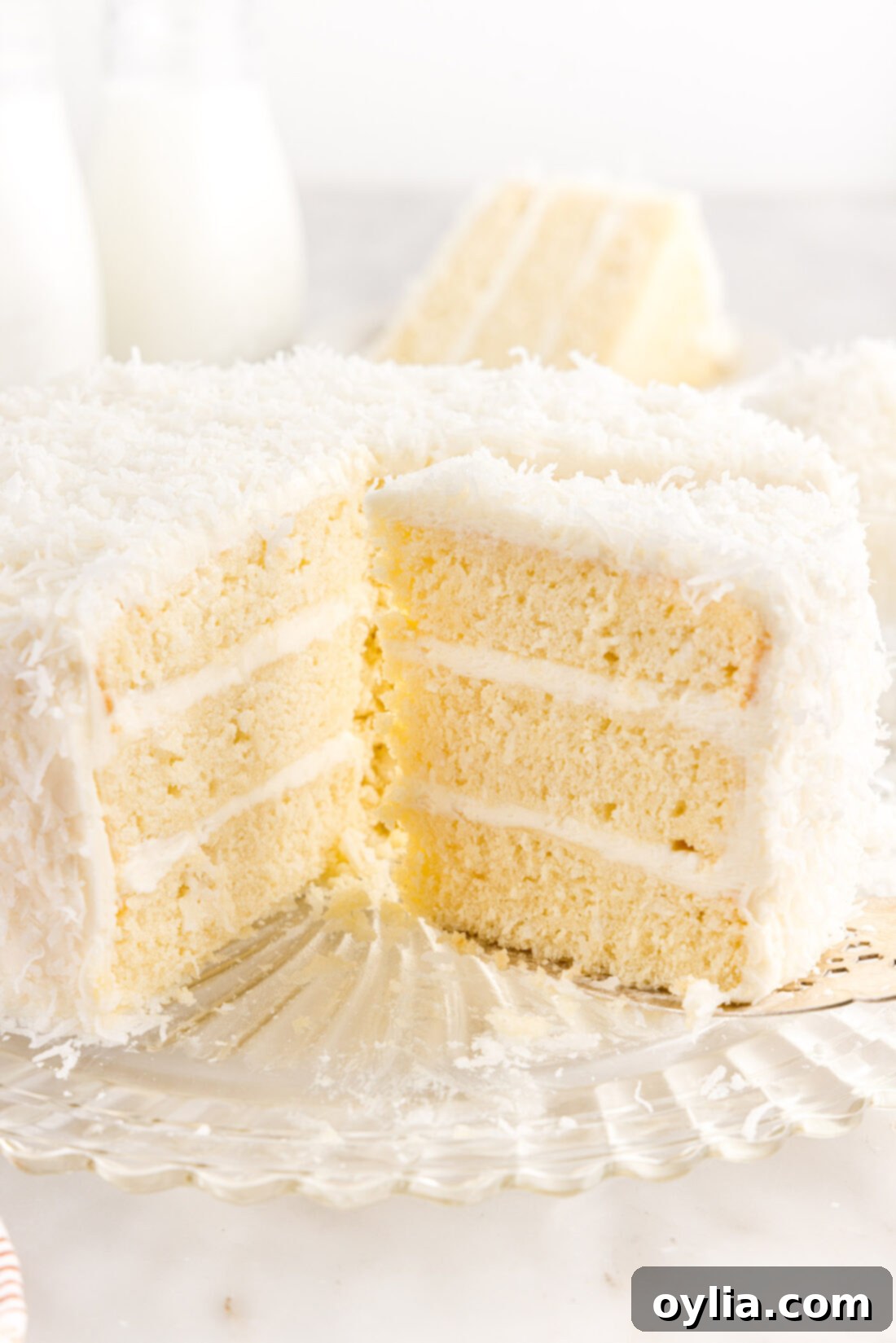
Serving Suggestions for Your Tropical Masterpiece
This moist coconut cake is more than just a dessert; it’s a statement piece, perfect for elevating any occasion. Its tropical charm and elegant presentation make it an ideal treat for a wide array of celebrations. Imagine it as the centerpiece for birthdays, adding a touch of exotic flair. It’s equally suited for the warmth of family gatherings during holidays, the joy of graduations, or as a sophisticated offering for retirement parties. But honestly, you don’t need a special reason to indulge in this delightful cake – sometimes, a “just because” moment is the best excuse of all.
To further enhance its visual appeal and flavor, consider garnishing the cake with toasted coconut instead of (or in addition to) plain shredded coconut. The toasting process brings out a deeper, nuttier coconut flavor and adds a beautiful golden hue. Instructions for toasting coconut are included in the recipe card below and also in the “Ingredient Info and Substitution Suggestions” section. Serve it with a fresh cup of coffee or a light herbal tea for a truly memorable experience. For an extra touch of decadence, a scoop of vanilla bean ice cream or a dollop of whipped cream can complement the rich flavors beautifully. Enjoy every blissful bite!
Explore More Delicious Cake Recipes
If you’ve loved creating this coconut cake and are eager to expand your baking repertoire, we have plenty more delightful cake recipes waiting for you. From vibrant and fruity to rich and classic, there’s a cake for every taste and occasion. Explore these other favorites:
- Zesty Lemon Cake: A bright and tangy treat, perfect for spring and summer.
- Classic Marble Cake: The best of both worlds with swirls of vanilla and chocolate.
- Joyful Funfetti Cake: A colorful and festive cake that’s always a hit at parties.
- Timeless Classic White Cake: Simple, elegant, and utterly delicious.
- Tropical Pineapple Coconut Cake: For those who can’t get enough of island-inspired flavors.
I absolutely adore baking and cooking, and nothing brings me more joy than sharing my kitchen experiences and cherished recipes with all of you! Remembering to come back each day for new culinary inspiration can sometimes be a challenge, which is why I offer a convenient newsletter delivered directly to your inbox every time a new recipe is posted. Simply subscribe here and start receiving your free daily recipes, ensuring you never miss out on your next favorite dish!
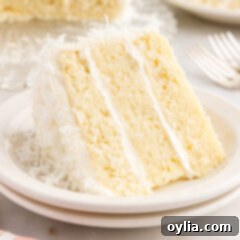
Coconut Cake
IMPORTANT – There are often Frequently Asked Questions within the blog post that you may find helpful. Simply scroll back up to read them!
Print It
Pin It
Rate It
Save ItSaved!
Ingredients
- 1 cup unsalted butter softened at room temperature
- 1 cup granulated white sugar
- 3 large eggs at room temperature
- 2 teaspoons coconut extract
- 1 teaspoon vanilla extract
- ½ cup cream of coconut
- 2 cups all purpose flour
- 2 teaspoons baking powder
- ½ teaspoon salt
- ¾ cup unsweetened coconut milk lite or regular
- 1 cup sweetened shredded coconut
Frosting
- 1 cup salted butter softened at room temperature
- 8 ounces cream cheese softened at room temperature
- 1 teaspoon vanilla extract
- 5 cups powdered sugar
- 2 Tablespoons heavy whipping cream optional
- 2 cups sweetened shredded coconut
Things You’ll Need
-
Hand mixer or stand mixer
-
Mixing bowls
-
Wire cooling racks
-
3 8-inch round cake pans
Before You Begin
- Toasted coconut can be used on top of and/or within the cake for an enhanced flavor and crunch. To toast coconut, spread it in a single layer on a baking sheet and bake for 3-5 minutes in a 350°F oven until golden brown. Remove from hot baking sheet immediately to stop the cooking process. Flaked or shredded coconut, sweetened or unsweetened, can be used based on your preference.
- Whole milk or 2% milk can be substituted for the unsweetened coconut milk in the recipe if you prefer a different liquid base. Rest assured, as long as you are using coconut extract and the cream of coconut, you will not miss out on any of that essential coconut flavor.
- You can prepare and fully assemble your coconut cake a day ahead of time. Store it in a cake stand fitted with a lid or a portable cake carrier. Because this cake has cream cheese frosting, it will need to be refrigerated.
- Store the cake covered with a lid or in a cake stand or carrier in the refrigerator for up to 5 days. For the best taste and texture, allow the cake to come to room temperature for about 30-60 minutes before serving.
Instructions
Cake Instructions
-
Preheat the oven to 350°F (175°C). Spray three 8” round cake pans with non-stick baking spray and line the bottoms with parchment paper for easy removal.
-
In a large mixing bowl, beat butter and sugar until light and creamy. Add one egg at a time, beating well after each addition to fully incorporate.
-
Add vanilla extract, coconut extract, and cream of coconut and beat well until thoroughly combined and smooth.
-
In a separate bowl, mix together the flour, baking powder, and salt. Ensure these dry ingredients are evenly distributed.
-
Alternate between adding the coconut milk and the flour mixture to the cake batter, mixing only enough to combine the ingredients after each addition. Avoid overmixing.
-
Gently fold 1 cup of shredded coconut into the batter using a spatula.
-
Divide the batter evenly between the three prepared cake pans.
-
Bake for 20 minutes, or until a toothpick inserted into the center comes out with just a few moist crumbs attached (not wet batter).
-
Cool cakes on a cooling rack for 10-15 minutes in their pans, then carefully turn them out from the pans and allow them to cool completely on the rack before frosting.
To Make the Frosting
-
In a clean bowl, cream together the softened butter and cream cheese until the mixture is completely smooth, lump-free, and fluffy.
-
Add powdered sugar, one cup at a time, beating well after each addition until fully combined.
-
Stir in vanilla extract and heavy cream, adding 1 tablespoon at a time, until the frosting achieves a fluffy and easily spreadable consistency.
-
Assemble the cake: Spread about 1⁄2 cup of frosting evenly on top of each cooled cake layer. Carefully stack the next layer and repeat, ensuring even distribution.
-
Spread the remaining frosting to fully cover the top and sides of the stacked cake. Finally, sprinkle shredded coconut generously over the top of the cake, then gently pat handfuls onto the sides to cover the cake completely, creating a beautiful finish.
Nutrition
The recipes on this blog are tested with a conventional gas oven and gas stovetop. It’s important to note that some ovens, especially as they age, can cook and bake inconsistently. Using an inexpensive oven thermometer can assure you that your oven is truly heating to the proper temperature. If you use a toaster oven or countertop oven, please keep in mind that they may not distribute heat the same as a conventional full sized oven and you may need to adjust your cooking/baking times. In the case of recipes made with a pressure cooker, air fryer, slow cooker, or other appliance, a link to the appliances we use is listed within each respective recipe. For baking recipes where measurements are given by weight, please note that results may not be the same if cups are used instead, and we can’t guarantee success with that method.
